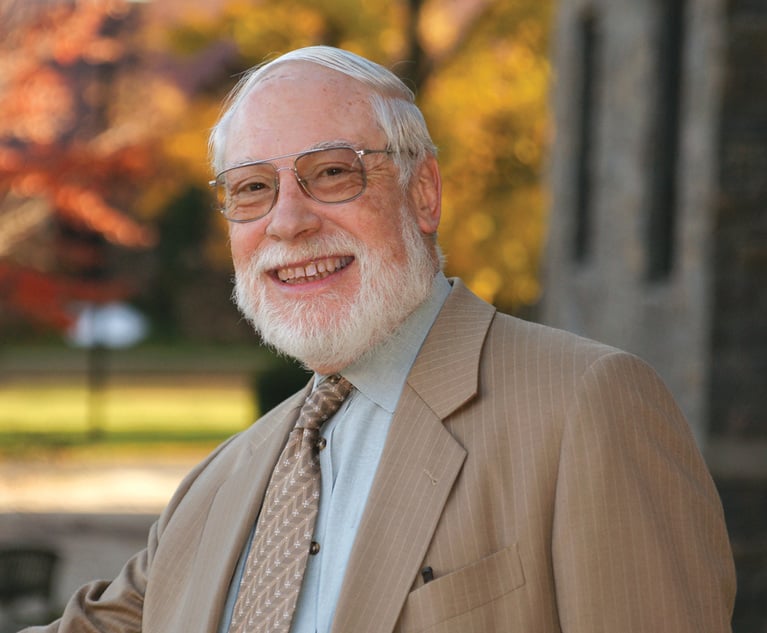New York's Evidence Guide: the Court System's 'Best Kept Secret'
The Guide has already been favorably received by some courts, including the Appellate Division.
September 10, 2019 at 11:00 AM
7 minute read
 A committee of the New York Unified Court System has published a Guide to New York Evidence (the Guide), written in Code style—a "rule" in a summary format, followed by a "note" setting forth the source, meaning, and nuances of the rule. The Guide is published on the New York State Unified Court System website.
A committee of the New York Unified Court System has published a Guide to New York Evidence (the Guide), written in Code style—a "rule" in a summary format, followed by a "note" setting forth the source, meaning, and nuances of the rule. The Guide is published on the New York State Unified Court System website.
Publication on the Internet rather than by a hard copy book allows, as explained on the Guide's website, "for more rapid dissemination of new rules and revisions and provides the bench and bar with free, widespread access, including in a courtroom via a computer, tablet, or smartphone." That does away with the need to carry an evidence tome to court.
The Guide has already been favorably received by some courts, including the Appellate Division. People v. Pascuzzi, 173 A.D.3d 1367 (3d Dept. 2019); People v. Figueroa, 171 A.D.3d 549, 550 (1st Dept. 2019); People v. Watson, 163 A.D.3d 855, 864 (2d Dept. 2018).
The committee responsible for the Guide's publication was commissioned by Chief Judge Janet DiFiore in 2016, as part of her Excellence Initiative. As the Chief Judge explained:
New York is one of the very few states that does not have a statutory code of evidence. Our law of evidence is scattered throughout thousands of judicial decisions, statutory provisions and court rules. For judges and lawyers, this is both frustrating and inefficient. This past July, I established an Advisory Committee on Evidence to create a single, definitive compilation of New York's law of evidence. Creating an accessible, easy-to-use guide for judges and lawyers will save research time, promote uniformity in applying the law, avoid erroneous rulings and improve the quality of legal proceedings.
The State of Our Judiciary, Jan. 22, 2017.
In years past, there were attempts to enact a statutory Code of Evidence. The most recent attempt was in 1991 when the Law Revision Commission, under the leadership of the late Prof. Robert Pitler, submitted a Proposed Code to the Legislature, with what the Commission said were "only limited, well-reasoned … changes." The Legislature rejected that Proposed Code. It is nonetheless worth noting that while aspects of the 1991 Proposed Code are out-of-date and do not in every respect reflect New York's current law of evidence, its comments to each proposed rule remain a valuable source for research on New York's law of evidence.
The 1991 Proposed Code failed to gain legislative approval for various reasons, including a belief by some that an evidence code would stop the common law advances in the law of evidence. See Barbara C. Salken, "To Codify or Not to Codify—That Is the Question: A Study of New York's Efforts to Enact an Evidence Code," 17 Pace L. Rev. 171 (1997). Ironically, a common law rule of evidence can become as static as a statutory rule, and at times it takes a legislative rule of evidence to move beyond an outmoded common law rule. See CPL article 60 and CPLR article 45. Those who believed that codification would not impede the growth of the law of evidence prevailed in most states and the federal government; but, alas, not in New York. See Salken, supra.
On rejection of the 1991 Proposed Code, New Yorkers remained without access to a readily available, centralized source of New York's law of evidence. Though not a satisfactory situation, it has persisted for decades.
In contrast to the 1991 Proposed Code, the Guide is not a legislative codification, and it adheres to the current law of New York as expressed in its statutes and controlling decisional law, with the focus of course on the decisions of the Court of Appeals. Thus, as the Guide rule 1.01 states: "the rules of evidence set forth in this Guide are not intended to alter the existing law of New York evidence and shall not be construed as doing so or as precluding change in the law when appropriate."
The Guide's committee includes Susan Phillips Read, retired judge of the Court of Appeals and co-chair; sitting judges of the Appellate Division; sitting and retired trial judges; and Michael J. Hutter, professor of the law of evidence who serves as the committee's Reporter. (The names of all committee members are posted on the website.) Each rule receives careful and studied consideration and passes through several drafts and levels of review before publication, including editorial review by the Law Reporting Bureau.
The goal of the committee is to provide a "one-stop shopping" guide to New York's prevailing law of evidence. To that end, the evidence rules of the Guide are organized into 10 articles. Articles one through nine have been completed and article 10 will be completed soon.
(1) General Provisions
(2) Judicial Notice
(3) Presumptions
(4) Relevance and Its Limits
(5) Privileges
(6) Witnesses and Impeachment
(7) Opinion Evidence
(8) Hearsay
(9) Authenticity and Identification
(10) Best Evidence Rule
The 10 articles parallel the organization of the Federal Rules of Evidence (FRE). That was done to assist in research and comparison of the rules. Again, however, the Guide recites the current New York law of evidence; the language of a rule adheres to the extent possible to a statute or controlling decisional law, especially from the Court of Appeals; language from the 1991 Proposed Code and the FRE may also be used, but only when that language embodies an existing New York rule of evidence. Once the basic articles are completed, rules may be added to the various articles as necessary, and existing rules may be revised as the law evolves.
The Internet version of the Guide is copyrighted by the New York State Unified Court System, and as stated on the Guide's website, no one is "authorized to publish a hard copy book of the Guide to New York Evidence for general circulation." For those who nonetheless prefer an individual hard copy for their sole use and not otherwise for publication, as further explained on the Guide's website, "there is, on the Table of Contents page of each article a document entitled: 'Article [#] Rules.' That is a single PDF document of all the rules in that article. A print of each of those pdf documents will result in a hard copy of the Guide to New York Evidence. Over time, however, there will be additional rules and revisions of existing rules; it will therefore be necessary to verify periodically that the printed copy remains a complete and up-to-date 'book.' If there is a revision of a rule, it will be noted both in the title of the rule and in the title of the 'Article [#] Rules' document."
When citing a Guide's rule or note, it is thus necessary to cite to the web address. There is on the website, in the Table of Contents, a section entitled "Guide Citation Form," which contains the State Reporter's recommended citation form.
In short, the Guide should provide the bench and bar with the reliable, quick-access guide to New York's law of evidence that they have long deserved.
William C. Donnino is a retired New York Supreme Court justice and co-chair of the committee commissioned for the Guide's publication.
This content has been archived. It is available through our partners, LexisNexis® and Bloomberg Law.
To view this content, please continue to their sites.
Not a Lexis Subscriber?
Subscribe Now
Not a Bloomberg Law Subscriber?
Subscribe Now
NOT FOR REPRINT
© 2025 ALM Global, LLC, All Rights Reserved. Request academic re-use from www.copyright.com. All other uses, submit a request to [email protected]. For more information visit Asset & Logo Licensing.
You Might Like
View All
Law Journal Column on Marital Residence Sales in Pending Divorces Puts 'Misplaced' Reliance on Two Cases
8 minute read

A Time for Action: Attorneys Must Answer MLK's Call to Defend Bar Associations and Stand for DEI Initiatives in 2025
5 minute readTrending Stories
- 1Trump's DOJ Delays Releasing Jan. 6 FBI Agents List Under Consent Order
- 2Securities Report Says That 2024 Settlements Passed a Total of $5.2B
- 3'Intrusive' Parental Supervision Orders Are Illegal, NY Appeals Court Says
- 4Federal Laws Also Preempt State's Swipe Fee Law on Out-of-State Banks, Judge Rules
- 5Judge Grills DOJ on Trump’s Birthright Citizenship Executive Order
Who Got The Work
J. Brugh Lower of Gibbons has entered an appearance for industrial equipment supplier Devco Corporation in a pending trademark infringement lawsuit. The suit, accusing the defendant of selling knock-off Graco products, was filed Dec. 18 in New Jersey District Court by Rivkin Radler on behalf of Graco Inc. and Graco Minnesota. The case, assigned to U.S. District Judge Zahid N. Quraishi, is 3:24-cv-11294, Graco Inc. et al v. Devco Corporation.
Who Got The Work
Rebecca Maller-Stein and Kent A. Yalowitz of Arnold & Porter Kaye Scholer have entered their appearances for Hanaco Venture Capital and its executives, Lior Prosor and David Frankel, in a pending securities lawsuit. The action, filed on Dec. 24 in New York Southern District Court by Zell, Aron & Co. on behalf of Goldeneye Advisors, accuses the defendants of negligently and fraudulently managing the plaintiff's $1 million investment. The case, assigned to U.S. District Judge Vernon S. Broderick, is 1:24-cv-09918, Goldeneye Advisors, LLC v. Hanaco Venture Capital, Ltd. et al.
Who Got The Work
Attorneys from A&O Shearman has stepped in as defense counsel for Toronto-Dominion Bank and other defendants in a pending securities class action. The suit, filed Dec. 11 in New York Southern District Court by Bleichmar Fonti & Auld, accuses the defendants of concealing the bank's 'pervasive' deficiencies in regards to its compliance with the Bank Secrecy Act and the quality of its anti-money laundering controls. The case, assigned to U.S. District Judge Arun Subramanian, is 1:24-cv-09445, Gonzalez v. The Toronto-Dominion Bank et al.
Who Got The Work
Crown Castle International, a Pennsylvania company providing shared communications infrastructure, has turned to Luke D. Wolf of Gordon Rees Scully Mansukhani to fend off a pending breach-of-contract lawsuit. The court action, filed Nov. 25 in Michigan Eastern District Court by Hooper Hathaway PC on behalf of The Town Residences LLC, accuses Crown Castle of failing to transfer approximately $30,000 in utility payments from T-Mobile in breach of a roof-top lease and assignment agreement. The case, assigned to U.S. District Judge Susan K. Declercq, is 2:24-cv-13131, The Town Residences LLC v. T-Mobile US, Inc. et al.
Who Got The Work
Wilfred P. Coronato and Daniel M. Schwartz of McCarter & English have stepped in as defense counsel to Electrolux Home Products Inc. in a pending product liability lawsuit. The court action, filed Nov. 26 in New York Eastern District Court by Poulos Lopiccolo PC and Nagel Rice LLP on behalf of David Stern, alleges that the defendant's refrigerators’ drawers and shelving repeatedly break and fall apart within months after purchase. The case, assigned to U.S. District Judge Joan M. Azrack, is 2:24-cv-08204, Stern v. Electrolux Home Products, Inc.
Featured Firms
Law Offices of Gary Martin Hays & Associates, P.C.
(470) 294-1674
Law Offices of Mark E. Salomone
(857) 444-6468
Smith & Hassler
(713) 739-1250







